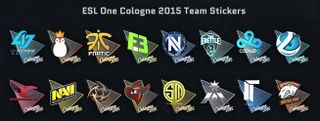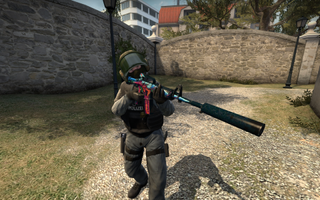How $400 virtual knives saved Counter-Strike
Conspicuous Consumption-Strike
There’s an even simpler explanation for the popularity that skins brought to Counter-Strike: they put money directly in the game. A lot of it. Not only did Counter-Strike have a persistent element for the first time, it had a form of progression that was worth real money. How much you’d accumulated in CS:GO became a measure of how serious of a player you were.
Skins became status symbols, bling that says something about you as a player. Holding a $2100 Dragon Lore AWP, the CS:GO equivalent of a gold-plated Lamborghini, instantly validates you as a savvy or ultra-dedicated player—not only do you have taste, but you have the means or the passion to acquire something unavailable ‘in stores’—the Steam Market places a $400 limit on listings.
No one could have predicted what would happen when one of the world’s most skill-driven FPSes made fashion a feature. But it has had a substantial impact on Counter-Strike’s competitive scene. Several third-party sites that allow players to bet skins on CS:GO esports matches have sprung up, one among them claiming to draw a million visitors each day.
After weapon skins were added, taking your opponent’s AWP or AK-47 took on a whole new meaning: it became a visual trophy.

Just as significantly, professional teams have gained a steady source of revenue outside of sponsors and tournament winnings. Teams that play in major tournaments (like the ESL One Cologne) receive a share of the sales of disposable in-game stickers associated with their team, and recently-added pro autograph stickers contribute even more to the pot. “Making $150,000 in pure sticker money—more than the tournament itself—is currently possible,” says Kovanen, who analysed these ‘Stickernomics’ last year.
And despite match-fixing incidents made possible by item gambling, most people in the scene will tell you that the addition of weapon skins has been extremely positive. “[Skins] have allowed for large betting companies and sites to be founded and existing ones to begin pouring money into the game,” says Kovanen. “Most importantly, beyond the visual improvements and the fun that is betting, it has made Counter-Strike incredibly much larger—it's been proven viewership grows exponentially when betting is available, and therefore the game as a whole would be a lot worse off without the item economy that has allowed for the game to flourish.”
“The combination of being the best FPS game and a purely cosmetic item economy was what pushed CS to where it is today. Change or take either of those away and you would mess with success,” says Kyle ‘Ksharp’ Miller, a veteran professional CS player and co-founder of Team 3D. “The true hardcore fans would still be there because they grew up on Counter-Strike, but I don't know if it would have attracted the next generation of players.”

If you got it, brandish it
When most people have something valuable, they want to flaunt it. They want to wear it out in public and have strangers ask about its origin or authenticity. Oh, this old thing? Owning a rare or expensive CS:GO skin became a status symbol, and an invitation to make videos, screenshots, or GIFs. CS:GO’s most passionate skinthusiasts were, whether they knew it or not, highly-effective marketers.
PC Gamer Newsletter
Sign up to get the best content of the week, and great gaming deals, as picked by the editors.
A mundane round of CS:GO’s deathmatch mode can draw hundreds of thousands of eyeballs if it showcases a hyper-rare variant of an already hyper-rare skin. Almost 3 million people have heard the inspirational tale of “From Nothing to A Knife,” one player’s saga of turning a $0.16 skin to a sub-$100 blade (set to some choice motivational speeches). CS:GO even has its equivalent to the depressingly popular Kinder Egg opening videos: case opening videos. Millions of people, as it turns out, will vicariously operate a slot machine that spits out virtual guns. And if you want to experience the thrill of opening virtual boxes without spending $2.50 a pop, you can poke around in a crate-opening simulator. Real-life replicas of CS:GO are up for grabs on eBay or Etsy (and are cheaper than their in-game equivalents).
CS:GO went from being a mostly outsourced project meant to bring Valve’s series to PS3 and Xbox 360 to the most popular competitive FPS of our generation. The money, popularity, and esports growth that skin mania has brought to Counter-Strike is immense, measurable, and will have long-lasting impact not only on CS but on other multiplayer games.
But even players who are indifferent, or even critical of the way skins have altered a once-pure competitive game have benefited from their introduction. The wave of attention has encouraged Valve to make significant improvements to CS:GO. An influx of new players brought more cheaters (even in the higher levels of competitive play), but Valve has done a lot more to mitigate and ban them. Classic maps like Train that were initially flawed in CS:GO have been reworked. And although CS:GO's tournaments don't yet reach the pomp and level of reward as The International, Valve puts up $250,000 for multiple majors throughout the year.
Even earlier this week Valve rebuilt CS:GO’s hitboxes, animations, and netcode work together, a seemingly mundane update that in fact addresses a long-standing complaint from hardcore players. Take or leave its luxury items, Counter-Strike has never been a better or more beloved game.

Evan's a hardcore FPS enthusiast who joined PC Gamer in 2008. After an era spent publishing reviews, news, and cover features, he now oversees editorial operations for PC Gamer worldwide, including setting policy, training, and editing stories written by the wider team. His most-played FPSes are CS:GO, Team Fortress 2, Team Fortress Classic, Rainbow Six Siege, and Arma 2. His first multiplayer FPS was Quake 2, played on serial LAN in his uncle's basement, the ideal conditions for instilling a lifelong fondness for fragging. Evan also leads production of the PC Gaming Show, the annual E3 showcase event dedicated to PC gaming.
Most Popular



